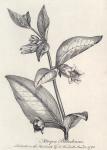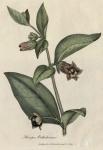001. Atropa Belladonna. Deadly Nightshade.

 Synonyma. Belladonna, Pharm. Edin.
Synonyma. Belladonna, Pharm. Edin.
Belladonna trichotoma, Socop. Carn. i. p. 160.
Belladonna caule herbaceo, brachiato, foliis ovato-lanceolatis, integerrimis. Hal. Stirp. Helv. N. 579.
Solanum Lethale, Clus. Hist. p. 86. Dod. purg. p. 360.
Solanum Melanocerasus, Bauh. Pin. 166.
Solanum majus, Cam. epit. p. 817.
Class Pentandria. Order Monogynia. L. Gen. Plant. 249.
Ess. Gen. Ch. Cor. campanulata. Stam. distantia. Bacca, globosa, 2-locularis.
Spec. Char. Atropa Belladonna, caule herbaceo, fol. ovatis integris.
The Belladonna has a thick whitish root, which is perennial, and sends forth strong, branched, annual, purple-coloured stems, from three to five feet high. The leaves are of unequal size, entire, oval, pointed, and stand in pairs upon short footstalks. The flowers are of a dark or brownish purple colour, large, pendent, bell-shaped, furrowed, and the limb cut into five segments. The whole plant is covered with fine hairs or down: the flowers appear in June or July, but the berries are not ripe till September, when they acquire a shining black colour. It grows in shady and stony waste grounds, but is not very common near London.
Whether this plant is the (greek) of Dioscorides or not, botanists have not yet ascertained, but it has certainly been long known as a strong poison of the narcotic kind; and the berries, though less powerful than the leaves, furnish us with many instances of their fatal effects, particularly upon children, who are readily tempted to eat this fruit by its alluring appearance and sweet taste.
[Sennert. lib. vi. par. 7. cap. 9. Lobel Stirpium Adversa. p. 103. Matthiolus Oper. Omn. p. 754. Oetinger de Belladonna. Aug. Vindel. Strychnomania, &c. Bodaeus à Stapel. Comment, in Theophrast. 586. Simon Pauli Quad. Botan. p. 488. Gerard's Herbal, 341. Wepser's Cicut. Aquat. Histor. et Noxae, p. 228. Boulduc. Histoire de l'Acad. a. 1703. Rosi Plant. Venen. p. 11. Boerhaave's Hist. Plant. Lugd. Bat. Hort. p. 510. Journ. de Med. arm. 1759. Gent. Magaz. 1747 & 1748. Hill's British Herbal, p. 329. Spielman's Diff. Veget. Venen. p. 16. Mapp. Pl. Alsat. p. 36. Murray's Apparat. Medicam. p. 431.
Many other recent facts of the same kind might be adduced from various periodical publications. Ray found by applying the leaves of the Belladonna near the eye, a remarkable relaxation of the uvea was produced. Sauvages (Nosol.) supposes that the Belladonna was the plant which produced such strange and dreadful effects upon the Roman soldiers, during their retreat (under the command of Anthony) from the Parthians; they are said to have " suffered great distress for want of provisions, and were urged to eat unknown plants: among others they met with an herb that was mortal; he that had eaten of it, lost his memory and his senses, and employed himself wholly in turning about all the stones he could find, and after vomiting up bile, fell down dead." Plutarch's Life of Anthony.—The Scotch historian, Buchanan, relates that the Scots mixed a quantity of the juice of the Belladonna (Solanum Somniferum) with the bread and drink, which by their truce they were to supply the Danes with, which so intoxicated them, that the Scots killed the greatest part of Sweno's army while asleep. Lib. vii.
Ray relates a curious instance of the effects of this plant in the following words: Hist. Plant, p. 680. Accidit, ni fallor, tempore Pontificis Maximi Urbani ultimi, ut quidam de famulitio Cardinalis magni nominis (ut mihi hîc Augustae retulit ejus hortulanus) infunderet in vino Malvatico herbam illam quam Bellam Donnam vocant, daturam alias per noctem ut ejus herbae effectus disserent; infusum hoc propinarunt cuidam fratri mendicanti ex conventu S. Hieronymi, qui Patavii Fratrum ignorantiae dicitur, à primo breve delirium, cachinni, gesticulationes variae; dein insania vera, post stupor mentis qualis est ebriorum vigilantium. Cardinalis pro ebrio in carcere includit; deinde à medico qui rem subolsecerat innocens pronuntiatur, qui aceti cyatho propinato, a dementia quam Bella Donna causavit eum liberat. Hachstellerus Decad. 7 Ob.
And Shakespeare in his Mackbeth makes Banquo say,
Or have we eaten of the insane root
That takes the reason prisoner.]
The number of these berries necessary to produce deleterious effects, may probably depend upon the state of maturity in which they are eaten: if not more than three or four be swallowed, according to Haller's account, no bad consequence ensues; "Baccae sapore fatuo dulci possunt absque noxa edi [Hort. Florent. p. 62.] si numerus tres quatuorve non excesserit: plures etiam a studioso medicinas Coloniensi nomine Simonis vidi deglutiri." Hal. Stirp. Helv. No. 579.
But when a greater number of the berries are taken into the stomach, scarcely half an hour elapses before violent symptoms supervene; viz. vertigo, delirium, great thirst, painful deglutition, and retching, followed by furor, stridor dentium, and convulsions; the eye-lids are drawn down, the uvea dilated and immovable; the face becomes red and tumid, and spasms affect the mouth and jaw; the general sensibility and irritability of the body suffer such great diminution, that the stomach often bears large and repeated doses of tart. emet. (gr. 14.) without being brought into action; the pulse is small, hard, quick, and subsultus tendinum, risus sardonius & coma, generally precede death. The body being opened, inflammation has been discovered in the intestines, mesentery, and liver, Comm. Nor. 1743, p. 61. And Boulduc, Hist. de l'Acad. des Sc. de Paris, 1703, p. 56. found the stomach of a child eroded in three places. It may be necessary to remark, that vinegar, liberally drunk, has been found very efficacious in obviating the effects of this poison; evacuations should however be always first promoted.
The leaves of the Belladonna were first used externally to discuss scirrhous and cancerous tumours, and also as an application to ill conditioned ulcers: their good effects in this way at length induced physicians to employ them internally for the same disorders, and we have a considerable number of well authenticated facts which prove them a very serviceable and important remedy.
[Junker's Conspect. Ther. Gen. Ed. 1725. p. 491. Journ. de Med. ann. 1766. Timmermann's Progr. Mich. Albertus de Belladonna. Tib. Lambergen, stated in the Phil. Trans. vol. 50. by Mr. Pultney. Comment, de Rebus, tom. 8. p. 654. Durlac Journ. de Med. t. 11. p. 449. Amoureux, l. c. tom. 13. p. 47. Marteau. l. c. tom. 14. p. 11. van den. Block. l. c. tom. 14. p. 108. Ludw. Advers. Pract.
vol. 1. P. 4. p. 637. and vol. 2. p. 314.
To which we may add the later authorities of Bergius, (Mat. Med. p. 128. vol. 1.) and Murray, App. Med. vol. 1. p. 440. who used them successfully in convulsions and epilepsy. The good effects of the berries may be learned from Gesner, Epist. p. 34. Eph. N. C. ann. 3. Obs. 64. Smetius, lib. 4. p. 238. Mayerne Prax. Med. Syntagm. Alt. p. 136.]
But it must likewise be confessed, that many cases of this sort have occurred in which the Belladonna has been employed without success:
[Heister Chirurgie, p. 328. Van. Der. Harr. over de Knierknoeft-en Kanker Gezwellen, p. 85. Van. Dovern. in litt. ad Timmermann Progr. Timmermann junr. ibid. Acrel. Chir. Händelser. p. 40. De Haen Rat. Med. tom. 2. p. 45. Schmuckero Chirurg. Wahrnehmungen, tom. 2. p. 150. And some accounts given of this plant by our own countrymen Gataker and Bromfield.]
this, however, may be said of every medicine; and though Dr. Cullen repeatedly experienced its inefficacy, yet the facts he adduces in confirmation of the utility of this plant, are clear and decisive: "I have had a cancer of the lip entirely cured by it; a scirrhosity in a woman's breast, of such a kind as frequently proceeds to cancer, I have found entirely discussed by the use of it; a sore a little below the eye, which had put on a cancerous appearance, was much mended by the internal use of the Belladonna: but the patient having learned somewhat of the poisonous nature of the medicine, refused to continue the use of it, upon which the sore again spread, and was painful; but upon a return to the use of the Belladonna, was again mended to a considerable degree: when the same fears again returning, the use of it was again laid aside, and with the same consequence of the sore becoming worse. Of these alternate states, connected with the alternate use of, and abstinence from, the Belladonna, there were several of these alternations which fell under my own observation."
The sensible effects produced by the leaves of this plant taken in medicinal doses, are usually by the skin, the urinary passages, and sometimes by stool; in larger doses troublesome dryness of the mouth and throat, giddiness, and dimness of sight are experienced.
That the advantages derived from the internal use of Belladonna are only in proportion to the evacuations effected by it, is a conclusion we cannot admit as sufficiently warranted by the facts adduced upon this point.
As this plant is very uncertain in its operation, the proper dose is with difficulty ascertained; the most prudent manner of administering it is by beginning with one grain or less, which may be gradually increased according to its effects. Six grains are considered as a very large dose.—With respect to the berries, so successfully employed as an anodyne, by Gesner and others, in dysenteries, a small spoonful (coch. parvum) of a syrup of the juice was the dose given.
The root seems to partake of the same qualities as the leaves, but is less virulent.

